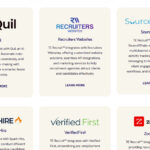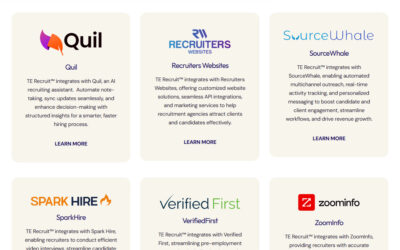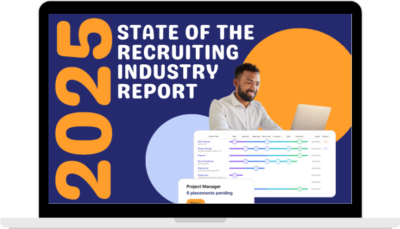If there’s one word that defines the recruiting industry in early 2025, it’s “conflicted.” After a rocky 2024—one of the most unpredictable years many recruiters can remember—the industry is now navigating a swirl of hope, headwinds, and hard choices.
A wide range of recruiters weighed in on how they’re experiencing the market, what they fear, and what they’re optimistic about. From one-person firms juggling high demand to seasoned veterans bracing for more uncertainty, the picture is one of contrast and complexity.
Let’s dive into the core themes that emerged from our recent State of the Recruiting Industry Survey.
1. A Split Market: Some See Growth, Others See Gridlock
While many recruiters expressed concern about the broader economy, others are experiencing strong demand.
“I’m currently seeing an increase in req flow from clients and requests to help in more than one location. This is exciting—and a bit scary as a solo operator!”
“We saw a significant uptick in new work in January, 2025, which led to an excellent Q1. The question is: will it continue?”
Several recruiters noted that despite fears about tariffs and inflation, demand for specialized roles—particularly in healthcare, biotech, architecture, and engineering—is keeping them busy.
“I currently have 3 biotech jobs (2 retainers) and 8 healthcare jobs. Clients are picky, good candidates are not open, bad candidates are open but nowhere to place them.”
But others painted a starkly different picture.
“2024 was the worst year we ever had revenue-wise. We’re seeing more search assignments in 2025, and I’m hopeful—but we’re not out of the woods yet.”
This divergence underscores an important truth: the recruiting industry isn’t a monolith. Market strength depends heavily on niche, geography, and how closely tied your work is to sectors hit hard by tariffs, offshoring, or interest rate fluctuations.
2. Tariffs, Tech, and Turbulence: Fears That Won’t Go Away>
For many recruiters, the uncertainty tied to tariffs and economic policy remains the single biggest obstacle to growth.
“The constant talk of tariffs is KILLING the economy. It’s driving uncertainty, delaying hiring, and fueling what could be the first recession entirely caused by bad economic policy.”
Others are worried about inflation, interest rates, and consumer resistance, especially in sectors like EV manufacturing and software sales.
“Fallout was driven by inflation, interest rates, and consumer resistance. Many clients went out of business or sold. It’s just a shake-up like the telecom days.”
This disruption has led to a pullback in hiring, with companies hesitant to commit to agency fees or long-term hires.
“Companies are trying to cut costs and that translates into not wanting to use recruiters. There are fewer openings and way more competition.”
“Profits are under pressure everywhere. Everyone’s trying to cut costs, and now I have more recruiters reaching out to work on my jobs than I ever have before.”
3. Artificial Intelligence: Enhancing or Replacing?>
The topic of AI sparked strong feelings across the board. For some, it’s a helpful tool that streamlines sourcing and engagement. For others, it threatens to depersonalize and devalue the profession.
“AI is a fear. It may displace recruiters.”
“Excited about AI but cannot see that as replacing fundamentals of recruiting. It should enhance performance, not the job itself.”
Recruiters are also seeing AI-related changes in candidate behavior.
“People don’t want to have live conversations anymore—so you don’t have a chance to make a difference.”
The shift toward automated communication, ghosting, and form-driven recruiting is frustrating for veterans who built their careers on relationship-driven placements.
“It’s all email now. No one calls in anymore.”
Despite the concerns, some see opportunity in adapting:
“I believe it’s more important than ever to have a concrete differentiator—something that gets attention and isn’t just ‘we find better candidates.’ AI is raising the bar, and we need to meet it.”
4. Oversaturation and Race to the Bottom
One of the most commonly voiced frustrations was the overcrowding of the recruiting landscape.
“Too many recruiters. Fewer clients. And many of the recruiters out there deliver poor quality.”
“The marketplace is crowded, and clients are conditioned to contingency recruiting.”
This has created a “race to the bottom” in pricing, especially for those not offering retained or engaged services.
“Unless you can earn engaged or retained work, your profits will shrink.”
Several recruiters also expressed concern that barriers to entry are too low, allowing inexperienced or unethical players to flood the industry.
“We’ve become oversaturated. Everyone who got laid off in TA now calls themselves a recruiter.”
Some are responding to this by niching down, adding HR consulting services, or focusing only on retained executive searches.
“Started to provide HR consulting to add value during this time. We need to show clients what can’t be replicated by in-house teams.”
5. Burnout, Passion, and Pivoting
Burnout is real. Many recruiters shared how emotionally draining the past year has been—especially those trying to support increasingly hesitant candidates and frustrated clients.
“I was getting severely burned out on my last specialty—and so were my candidates. Pivoting slightly into a new medical field has helped.”
“I hate holding hands with candidates in the manner that this younger generation requires to get them across the finish line.”
At the same time, others expressed a renewed commitment to the work—even as the environment grows more complex.
“It is a passion that excites me. When I can afford to, I would do it for free.”
“I still love my work, but it’s all about the people—not the money. The money will come when you do the right thing.”
Others pointed to the need for stronger industry-wide standards and ethics, similar to associations in the UK.
“I would like to see a Recruiting Confederation like they have in England—one that speaks for the industry, sets ethical standards, and stands up to companies who take advantage of candidates and agencies.”
6. Looking Ahead: Hope, Strategy, and Reinvention
Despite the frustrations and fears, many recruiters remain cautiously optimistic about the second half of 2025 and beyond.
“The future is good! Once hiring picks up again, the skilled labor shortage means more companies than ever will need us.”
“I’m hopeful that we’ve got 4–5 good years ahead once the new administration puts its policies into place.”
Others are inspired by the evolving needs of clients, especially around remote work, hybrid models, and digital transformation.
“My architecture and engineering clients are already investing in BIM (Building Information Modeling). That, plus flexible work schedules, is appealing to top talent.”
But the road ahead won’t be easy—and recruiters know it.
“The market is average right now, and the sentiment is just so-so. Hoping for a hiring spree midyear, but I’m also fearful of continued cost-cutting and layoffs.”
“I’ve been in this for 25+ years. This is one of the worst markets I’ve seen—but I also feel strongly that the future will be great.”
Final Thoughts: Adaptation Is the New Advantage
The recruiting industry in 2025 is not broken, but it is under pressure. There’s no question that economic headwinds, AI disruption, oversaturation, and shifting expectations are testing the profession like never before.
But if there’s one thing this industry has always done well, it’s adapt.
Whether it’s by doubling down on niche specialties, finding new ways to show value, or rethinking the recruiter-client relationship, those who evolve will not just survive—they’ll lead the next phase of growth.
“I believe recruiting is still an excellent career path for someone who is focused and willing to work at it.”
That sentiment sums it up perfectly. Recruiting isn’t for the faint of heart—but for those who stay committed to their craft and keep reinventing themselves, the future still holds plenty of promise.









